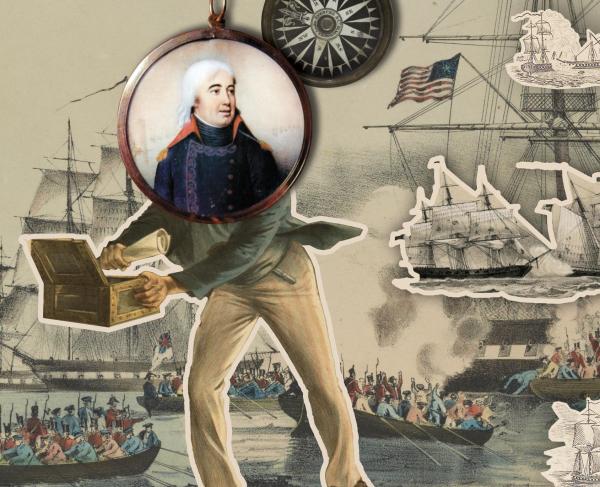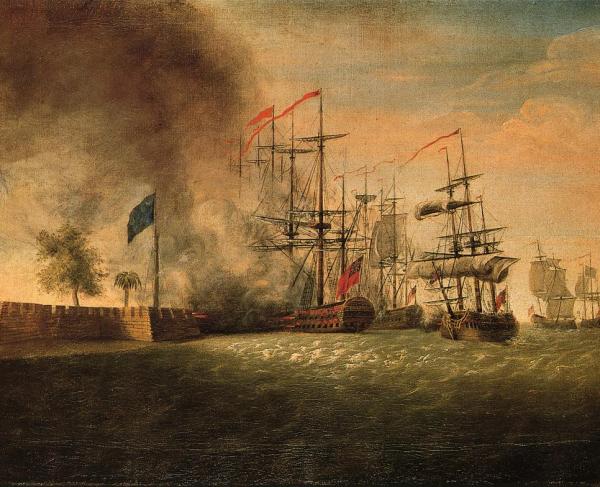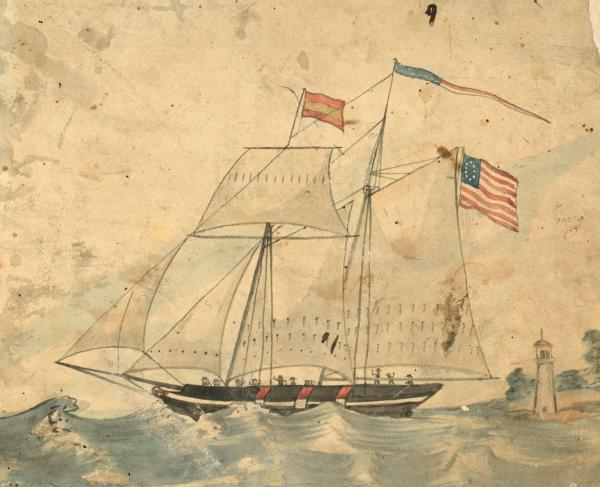
H.L. Hunley by Conrad Wise Chapman.
Submarines are the silent hunters of the deep. From the large nuclear-powered boats of today’s navies, to the German U-Boats of the First and Second World Wars, these machines hidden beneath the waves can change the course of history. In the United States, the first submersible was the Turtle with an egg-shaped hull designed by David Bushnell. This hand-powered submarine was used in a failed attempt to sink the British ship HMS Eagle in New York Harbor in 1776. Nearly one hundred years later the HL Hunley, a submarine built by the Confederate States of America, would become the first to sink an enemy vessel during the American Civil War.
The HL Hunley, simply known as Hunley, received her name from the financial backer of the project, Horace Lawson Hunley. Hunley provided funds for shipbuilder James McClintock to design and build three submarines. One was the Pioneer, built in New Orleans, and the American Diver and Hunley, built in Mobile, Alabama. The Pioneer was the first to be built and tested in the Mississippi River in February 1862. More trials were to commence, but because of the Union advance on New Orleans, the submarine was scuttled.
Hunley and his cohorts moved to Mobile, where they began developing American Diver. The team experimented with electric and steam-powered propulsion for this submarine but reverted to the hand-cranked system. This submarine was towed to the mouth of Mobile Bay to attack the Union blockade but sank in choppy water, never to be recovered.
Shortly after this sinking, the construction began on the Hunley. Upon completion, the Hunley measured in at forty feet long, the hull only four feet three inches high, and could hold a crew of up to eight people; seven to work the hand-cranked screw propeller and the eighth to pilot. It had ballast tanks, hand pumps, two watertight hatches, and two conning towers. In July 1863, Hunley was ready for a demonstration in Mobile Bay, which went well. The submarine was shipped by rail to Charleston, South Carolina, where it arrived on August 12th.
From here on, the submarine operated in the Confederate military going by the name CSS Hunley, though it was never officially commissioned into service. Horace Hunley continued with testing and operation. The submarine sank a total of three times. The first was on August 29th, when the submarine and its crew were about to make a dive in the harbor when an accident occurred that caused her to sink, killing five out of the eight crew. The boat was raised and put back into service. The second time was a few months later, on October 15th. The Hunley went under during a mock attack and never resurfaced. All hands were lost, including Horace Hunley himself. The boat would be raised once more.
Now beginning her third cruise, the Hunley received its armaments. Initially, it was planned to have a torpedo (in the 19th century “torpedo” was another word for floating mine). The floating explosive charge was to be towed behind the submarine. As it approached an enemy ship, Hunley would dive under the ship and resurface on the other side, thus putting the ship in between the explosive and the submarine. This was declared too dangerous, so a spar torpedo was attached instead. A spar torpedo is a copper cylinder containing gunpowder, which was attached to the submarine's bow by a twenty-two-foot pole. The torpedo would be rammed into a ship and detonated one of two ways: mechanically as the submarine pulled away or on impact electronically.
On the night of February 17, 1864, the HL Hunley made history as the first submarine to sink an enemy vessel. The USS Housatonic was a wooden-hulled, steam-powered sloop-of-war that carried twelve large cannons. She was stationed offshore in Charleston Harbor as part of the Union blockade. Lieutenant George E. Dixon was in command of Hunley, and the crew of eight successfully attacked Housatonic. Ramming the ship with the spar torpedo, it exploded and sank in five minutes. After the attack, Hunley did not return to base. Her disappearance left a mystery for more than one hundred years.
When the submarine was found in April 1995, it lay some four miles offshore, in thirty feet of water and covered in silt. Divers from a National Underwater and Marine Agency (NUMA) team were able to expose the forward hatch and the ventilator box to identify that it was, in fact, the Hunley. The wreck was donated to the state of South Carolina shortly after its discovery. The investigation underwater continued and culminated with the raising of the submarine on August 8, 2000. At 8:37 am, Hunley broke the surface for the first time in 136 years to be greeted by cheering spectators. The operation concluded when the submarine was taken to the Warren Lasch Conservation Center in North Charleston, built explicitly for Hunley. Through more investigation of both the boat and the crew’s remains (still inside when recovered), it was determined that the boat’s own torpedo was the cause of her sinking. There was no damage to the hull, and the crew were found still at their stations, thus disproving theory that they suffocated or drowned because there was no sign of struggle to escape. Researchers at Duke University concluded that the blast from the torpedo caused a shock wave that ruptured the crew’s lungs, either killing them instantaneously or incapacitating them and causing their submarine to sink.

The crew were removed from the boat and were identified through DNA testing. Their relatives were found (four of the crew were American, and four were of European descent). On April 17, 2004, the crew's remains were laid to rest at the Magnolia Cemetery in Charleston. Tens of thousands of people were in attendance, including reenactors as well as color guards from all five branches of the U.S. military.
Today, the Hunley is on display in a conservation laboratory inside a preserving tank of water at the Warren Lasch Conservation Center. The exhibit includes a replica of Hunley, which visitors can enter.


